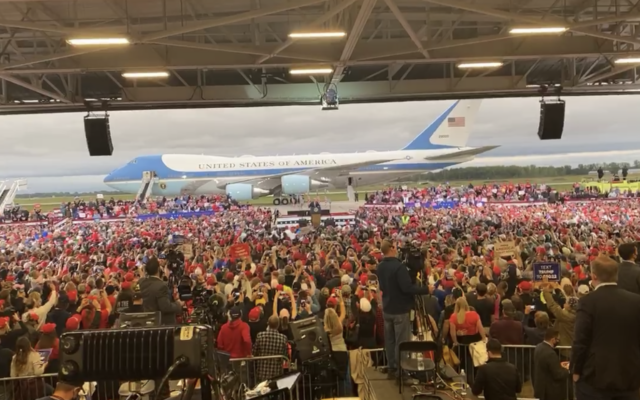Rechanneling the boom-and-bust history of Butte, Montana

▶ Watch Video: The history and future of Butte, Montana
At the top of the Continental Divide, under the watchful eye of “Our Lady of the Rockies,” sits the town of Butte, Montana.
Rayelynn Brandl grew up here, riding bikes like local hero Evel KnIevel on what was once called “The Richest Hill on Earth,” thanks to Butte’s incredibly productive copper mines.
“It was wonderful; it was absolute freedom,” Brandl said. “We rode our bikes everywhere, we built trails.”
Brandl’s childhood was in many ways idyllic. What she didn’t know was that she and her friends were playing on piles of toxic mine waste.
“Mining in Butte started in the 1800s,” she told correspondent Luke Burbank, “and so, these waste piles were always part of our lived experience. So, dirt, you know, to me was this yellow-orange granitic sort of stuff that didn’t grow anything. I didn’t know that, you know, dirt naturally was stuff that grew things!”
These “tailings,” as they’re called, were the remnants of a boom-and-bust mining economy that, during the boom, had Butte boasting one of the most productive copper mines in the world, the Anaconda. At one time Butte was the largest city between Chicago and San Francisco.
But then came the bust, or more accurately, a series of busts, the final nail being the closing of the Berkeley copper mine in 1982.
“It was very abrupt,” Brandl recalled. “And I was little. I was a sixth grader, I think. And I remember thinking, ‘What’s gonna happen to my friends?’ And then it didn’t just affect the mine, of course; it affects all of the other industries that supported the mine. So, everybody’s jobs were in jeopardy. I remember feeling, like, just sad.”
In fact, “CBS Sunday Morning” visited Butte back then, and produced this 1983 cover story:
With the mine shut down, the Berkeley pit filled with toxic water rich in heavy metal, and Butte was left to try to repair the damage of years of resource extraction – and the town earned the dubious distinction of becoming one of the largest Superfund sites in the country. The “scarlet letter” of being a Superfund site led Butte to become the butt of jokes.
It didn’t help that the Chamber of Commerce decided to charge admission to see the Berkeley pit, which had become an eerily-beautiful toxic lake, as reported in this 2006 story on “The Daily Show.”
Jon Sesso appeared in that “Daily Show” story, much to his chagrin. “The citizens and all the families that grew up in this town are very proud of their heritage, being from Butte,” Sesso told Burbank today. “You know, the Superfund thing, it’s, like, ‘Oh jeez, it’s the biggest Superfund site in the United States? That is the moniker we gotta get rid of, because it’s not true anymore.”
Last year Sesso, Butte’s former Superfund coordinator and a state senator, helped negotiate a plan to clean up the final section of Butte’s Superfund complex, in a 900-page consent decree, the result of a whopping 30 years of negotiations between Atlantic Richfield, the county, and the Environmental Protection Agency.
If you walk Butte today, you’ll notice the hillsides are no longer barren; and attics in Butte’s old homes are being cleaned for a century’s worth of toxic dust … the cost for being the nation’s leading copper producer.
“We call it pennies from hell,” said Sesso. “You know, we paid our dues. And we see now what happens if there are no environmental laws, if the almighty dollar takes precedent over taking care of the globe, taking care of your environment. It has to be in balance. And I would say our citizens are much more attuned to that reality than, you know, others.”
And yet, despite its complicated history, mining is still taking place in Butte, by a company called Montana Resources that claims it’s found ways to extract the Earth’s riches safely.
It’s also Montana Resources’ job to dissuade migrating waterfowl who tend to want to visit the Berkeley pit – something they do with sound cannons and even high-tech drones.
“We’ve, you know, essentially fixed a city,” said Brandl.
In an ironic twist, many of Butte’s mining jobs have been now replaced by jobs aimed at fixing the environmental damage. Raelynn Brandl has one of those jobs, running the Clark Fork Watershed Education Program, which teaches children about the environment and conservation: “When we bring students out here and we show them, we point to this grassy hillsides that you see everywhere [that] used to be yellow dirt, just like the mining property, they’re like, ‘No way!’ We’re like, ‘Yes! It was like that.”
Through tireless work and dedication to this rugged piece of the Mountain West, Brandl and so many other “Buttians,” as they’re known, are looking to prove there’s still a lot of value, even all these years later, in “The Richest Hill on Earth.”
Brandl said, “We are a model of what can be done when a citizenry is active and informed and educated, and willing to do the work, and stays with the topic. You know, it took 30 years. People have, you know, invested their entire careers in making that happen. And that’s what I think the story of Butte is.”
For more info:
- Butte Elevated
- Butte (Montana Office of Tourism)
- The Richest Hill (Podcast)
- Clark Fork Watershed Education Program
- Montana Resources
- PitWatch.org
Story produced by Anthony Laudato. Editor: Mike Levine.



